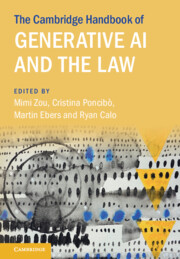Book contents
- The Cambridge Handbook of Generative AI and the Law
- The Cambridge Handbook of Generative AI and the Law
- Copyright page
- Contents
- Figures
- Tables
- List of Contributors
- Foreword
- Preface
- Part I Understanding Generative AI from Multidisciplinary Perspectives
- Part II Evolving Regulatory and Governance Frameworks
- Part III Generative AI
- 14 Generative AI and Non-discrimination Law in the EU
- 15 Generative AI and Data Protection
- 16 Generative AI and the Fundamental Limitations of US Privacy Law
- 17 Generative AI and IP Under US Law
- 18 Copyright and Generative AI in Japan and China
- 19 Redefining Rivalry
- 20 Regulating Hypersuasion
- 21 Generative AI Systems and Corporate Governance, Compliance and Liability
- 22 Generative AI and Criminal Guilt
- Part IV The Use of Generative AI in Legal and Related Sectors
16 - Generative AI and the Fundamental Limitations of US Privacy Law
from Part III - Generative AI
Published online by Cambridge University Press: 08 August 2025
- The Cambridge Handbook of Generative AI and the Law
- The Cambridge Handbook of Generative AI and the Law
- Copyright page
- Contents
- Figures
- Tables
- List of Contributors
- Foreword
- Preface
- Part I Understanding Generative AI from Multidisciplinary Perspectives
- Part II Evolving Regulatory and Governance Frameworks
- Part III Generative AI
- 14 Generative AI and Non-discrimination Law in the EU
- 15 Generative AI and Data Protection
- 16 Generative AI and the Fundamental Limitations of US Privacy Law
- 17 Generative AI and IP Under US Law
- 18 Copyright and Generative AI in Japan and China
- 19 Redefining Rivalry
- 20 Regulating Hypersuasion
- 21 Generative AI Systems and Corporate Governance, Compliance and Liability
- 22 Generative AI and Criminal Guilt
- Part IV The Use of Generative AI in Legal and Related Sectors
Summary
This chapter explores the privacy challenges posed by generative AI and argues for a fundamental rethinking of privacy governance frameworks in response. It examines the technical characteristics and capabilities of generative AIs that amplify existing privacy risks and introduce new challenges, including nonconsensual data extraction, data leakage and re-identification, inferential profiling, synthetic media generation, and algorithmic bias. It surveys the current landscape of U.S. privacy law and its shortcomings in addressing these emergent issues, highlighting the limitations of a patchwork approach to privacy regulation, the overreliance on notice and choice, the barriers to transparency and accountability, and the inadequacy of individual rights and recourse. The chapter outlines critical elements of a new paradigm for generative AI privacy governance that recognizes collective and systemic privacy harms, institutes proactive measures, and imposes precautionary safeguards, emphasizing the need to recognize privacy as a public good and collective responsibility. The analysis concludes by discussing the political, legal, and cultural obstacles to regulatory reform in the United States, most notably the polarization that prevents the enactment of comprehensive federal privacy legislation, the strong commitment to free speech under the First Amendment, and the “permissionless” innovation approach that has historically characterized U.S. technology policy.
Information
- Type
- Chapter
- Information
- The Cambridge Handbook of Generative AI and the Law , pp. 255 - 269Publisher: Cambridge University PressPrint publication year: 2025
